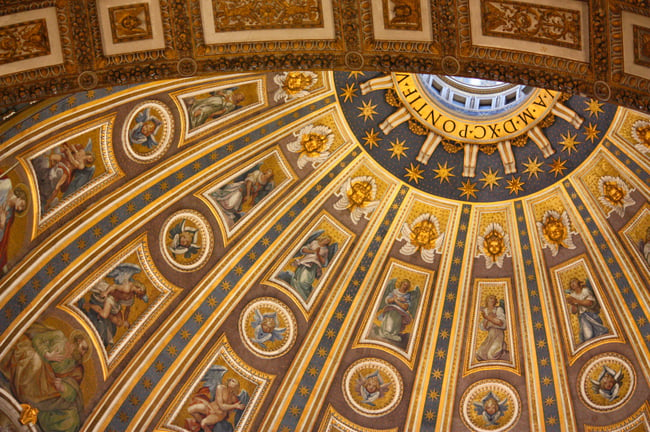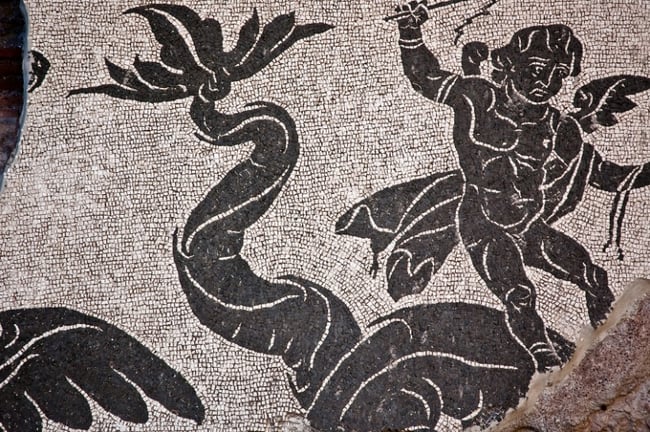

Rome is home to the world’s highest concentration of mosaics. From Byzantine floors to medieval walls to Renaissance ceilings, Italy’s illustrious capital is full of spectacular mosaic art.
If you’re interested in pursuing an art history degree, Rome offers an immersive experience studying a diverse range of art in its original, historic setting. The city’s inspiring art scene, including its impressive array of mosaics, is one of the reasons it remains one of the most popular study abroad destinations worldwide.
Art History Degree Basics: The Roman/Mosaic Connection
While Greeks appear to have been the first mosaic craftsmen, the Romans carried the art form further afield – spreading Greek-inspired mosaic artwork throughout their eventual empire via the elite Italian upper class. Once mosaics had made their way from Hellenistic Greece to the Roman Republic, wealthy Italians popularized the mosaic as a kind of luxury art form; a means of filling their villas with versatile art that mirrored the era's fashionable wall paintings.
Over the Early Christian and Byzantine centuries, mosaics evolved from patterns of pebbles set in terra cotta to the fine, precisely cut tiles Greeks named “tesserae.” Over the centuries, tesserae have proved to be among the most resilient of all traditional art materials.
Made of stone, colored glass, or ceramics set in clay or lead, they came to constitute the most complex, beautiful mosaics of Rome. And luckily for the modern art history student, many of these mosaics still survive intact all around Italy’s capital city – everywhere from the humblest piazza to the grandest and holiest of basilicas.
Mosaics in the Vatican: Exploring St. Peter’s Golden Lining
You may recognize the dome of St. Peter’s Basilica as the dominant shape on the Roman skyline, and its interiors are equally imposing. The mosaics on its ceiling famously feature ‘gold smalti’ - tiles made by sandwiching gold leaf between two layers of glass tile (“trasparenti”). Walking into St. Peter’s Basilica, it’s difficult not to be moved by the light and splendor these tiles reflect, even centuries after their setting.

The dome’s mosaics were created between 1603 and 1612 by Domenico Fontana and Giacomo Della Porta. Successors of Michelangelo, they used precious materials to bring his design for the dome’s ceiling to life.
If you take the opportunity to study art history in Italy, you can see Michelangelo’s vision with your own eyes in St. Peter’s Basilica. Look out for fine mosaic techniques called opus musivum and vermiculatum – thousands of tesserae arranged like halos, emanating in ripples out from the mosaic’s holy figures to the dome’s edges. And after admiring this ceiling, a short walk will take you to the Vatican museums, where further wonders abound, such as Michelangelo’s iconic Sistine Chapel,
Visit the Caracalla Baths When You Study Art History in Italy
The Vatican Museums feature some relics from the ancient Baths of Caracalla - but study abroad students can choose to visit the remains of Caracalla on site, to see its famous mosaics in their original settings.
The Caracalla Baths were designed as a 62 acre bathhouse by Emperor Caracalla, who reigned over Rome from 198 – 217 AC. Its mosaics are the art world’s most notorious example of that era’s emerging “Roman style” of mosaics, involving black and white tesserae set into marine motifs.
Students at art history schools in Italy who visit the Baths of Caracalla can notice the literally miniscule details that made this historic décor so influential. Arranged using techniques of opus regulatum (straight rows and columns) and opus paladanium (irregular shapes in chaotic combinations), its style spread in popularity from Africa to Antioch with the spread of the Roman Empire.

As well as visiting this landmark to study, art history students can also choose to attend the Baths’ concerts which frequently feature the Rome Opera and guest artists like Bob Dylan and Elton John. And students inspired by the site’s craftwork can even try their hand at creating their own Roman-inspired fine art in special studio classes offered by JCU.
If these adventures appeal to you, consider fitting a study abroad term into your art history degree program, or spending a full four-year program surrounded by the beautiful historic landscape Italy has to offer.
Visit JCU to start making your study abroad plans today. And if you’re interested in exploring art history with your own hands, apply for our 2016 student field project: the excavation of Rusellae.




